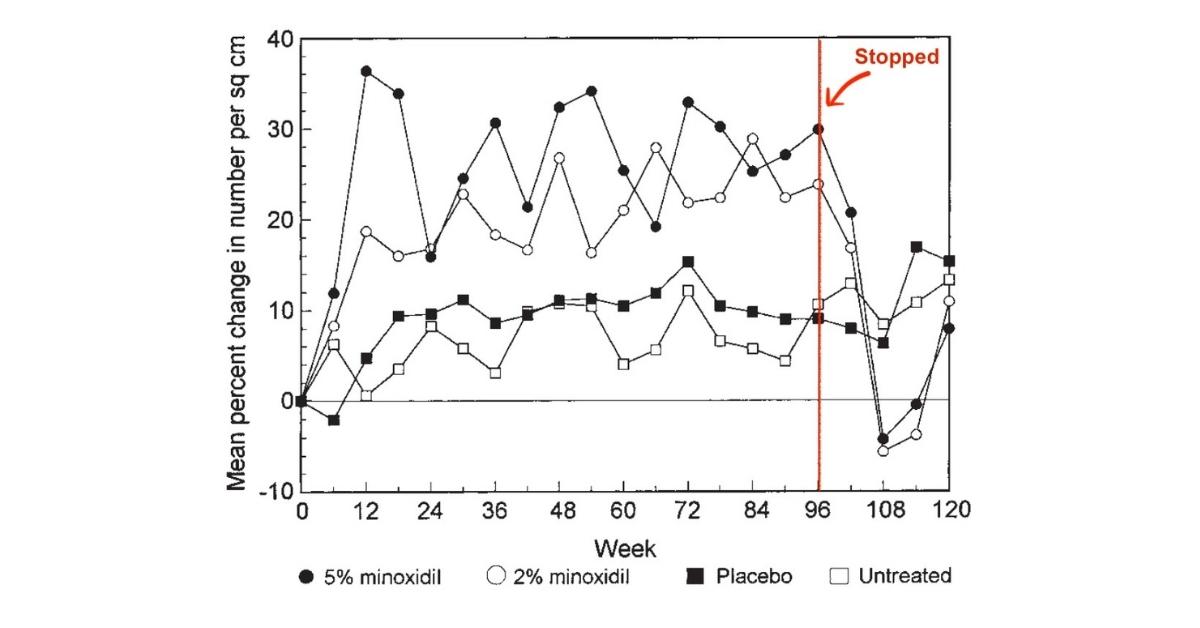Studies show that within 3-6 months of stopping minoxidil, any hair growth resulting from the drug is lost. After quitting minoxidil, hair counts can even temporarily fall below where they would’ve been had we never sought treatment at all, before eventually rebounding back to baseline.
Why does this happen? Is there a way to lessen the “withdrawal shed” from minoxidil? For those who’ve seen hair gains with minoxidil but prefer not to use it forever, there may be some methods to mitigate shedding after quitting minoxidil. This article explains the evidence, and provides an action plan.
- About Minoxidil
- Why People Stop Taking Minoxidil
- What Happens When Quitting Minoxidil
- Is Minoxidil Plus Microneedling the Answer?
- How to (Possibly) Prevent Shedding After Stopping Minoxidil
About Minoxidil
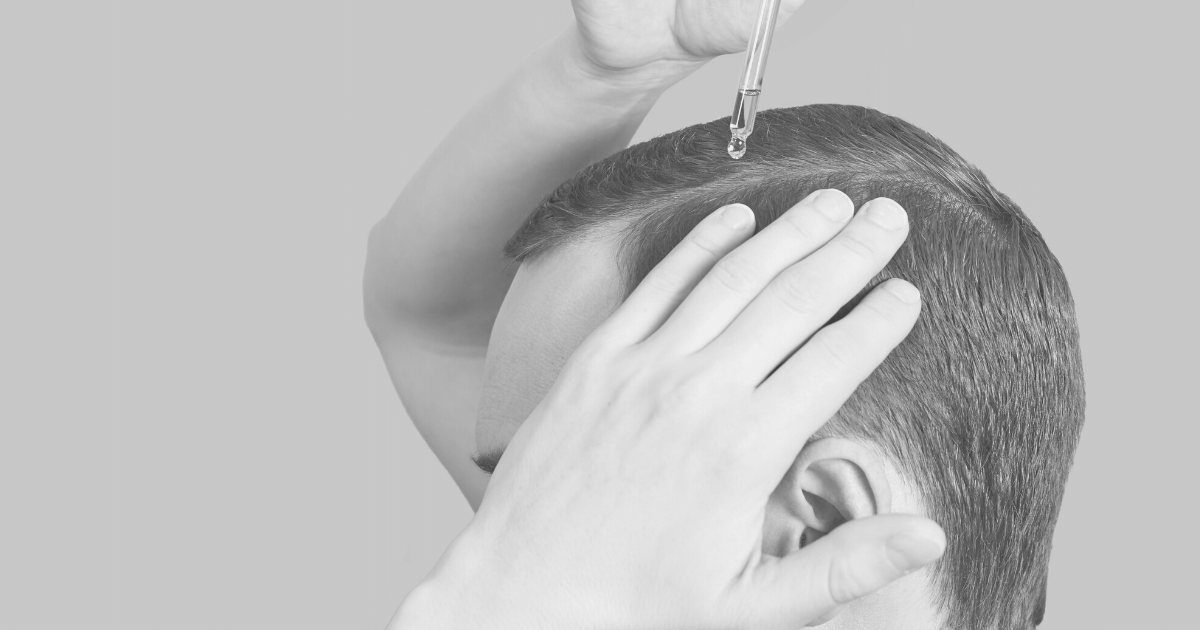
Minoxidil is an over-the-counter drug approved by the FDA to treat androgenic alopecia. It’s commonly known by the brand name Rogaine. Along with finasteride, minoxidil is one of only two drugs approved to treat androgenic alopecia in both men and women.
Nobody actually knows how minoxidil works. Minoxidil was initially developed in the 1980s as an oral drug to treat high blood pressure. But when patients started reporting “unwanted” hair regrowth after three or more months of use, its manufacturers decided to reformulate it into a topical and begin testing it on men with androgenic alopecia.[1]https://www.jaad.org/article/S0190-9622(08)00809-8/abstract
Today, we still aren’t sure how it works. But since side effects are minimal, it was nonetheless approved by the FDA for use. There are two primary hypotheses on the mechanisms behind minoxidil.
Hypothesis 1: Minoxidil is a Vasodilator
One defining characteristic of androgenic alopecia is reduced blood flow to balding regions. While there’s debate over whether reduced blood flow is a consequence or cause of hair loss, it’s undisputed that without proper blood supply to a hair follicle, hair cannot grow.
As a vasodilator, minoxidil widens blood vessels, potentially increasing blood flow to the scalp. In addition, Minoxidil opens potassium ion channels, which some researchers think works alongside vasodilation to improve hair growth.[2]https://pubmed.ncbi.nlm.nih.gov/9395721/
Hypothesis 2: Minoxidil Alters the Hair Growth Cycle
It’s possible that minoxidil kicks miniaturizing hair follicles back into the anagen (growth) phase of the hair cycle. Hairs thus become thicker, giving the appearance of overall improved hair density. This could be the result of minoxidil decreasing prostaglandin D2 levels while boosting other prostaglandins, like prostaglandin E2, to downregulate pro-inflammatory growth factors that are linked to hair shedding.[3]https://www.jidonline.org/article/S0022-202X(15)42806-4/pdf
In addition, Minoxidil may prolong the growth phase of the hair cycle by maintaining beta-catenin activity in dermal papilla cells.[4]https://pubmed.ncbi.nlm.nih.gov/21524889/
How Long Does Minoxidil Take to Work?
Minoxidil’s event horizon is approximately 3-6 months. Over half of the people who try it respond to minoxidil within this time frame. But early results tend to wane over time.
One study found that at six months, men using 5% minoxidil twice-daily saw a near-60% change in hair ‘weight’ in balding regions.[5]https://www.sciencedirect.com/science/article/pii/S019096229970006X In other words, their hair had thickened or regrown to weigh 60% more than it did at the start of the study.
That’s huge.
Unfortunately, the same study showed that at 96 weeks, those hair weights decreased to merely 25% higher than baseline. This also happens to be a consistent finding across most studies on minoxidil. Just see this 48-week chart on the effects of 2% and 5% minoxidil on hair counts.[6]https://pubmed.ncbi.nlm.nih.gov/12196747/ Results tend to peak at week 16, then decline thereafter.
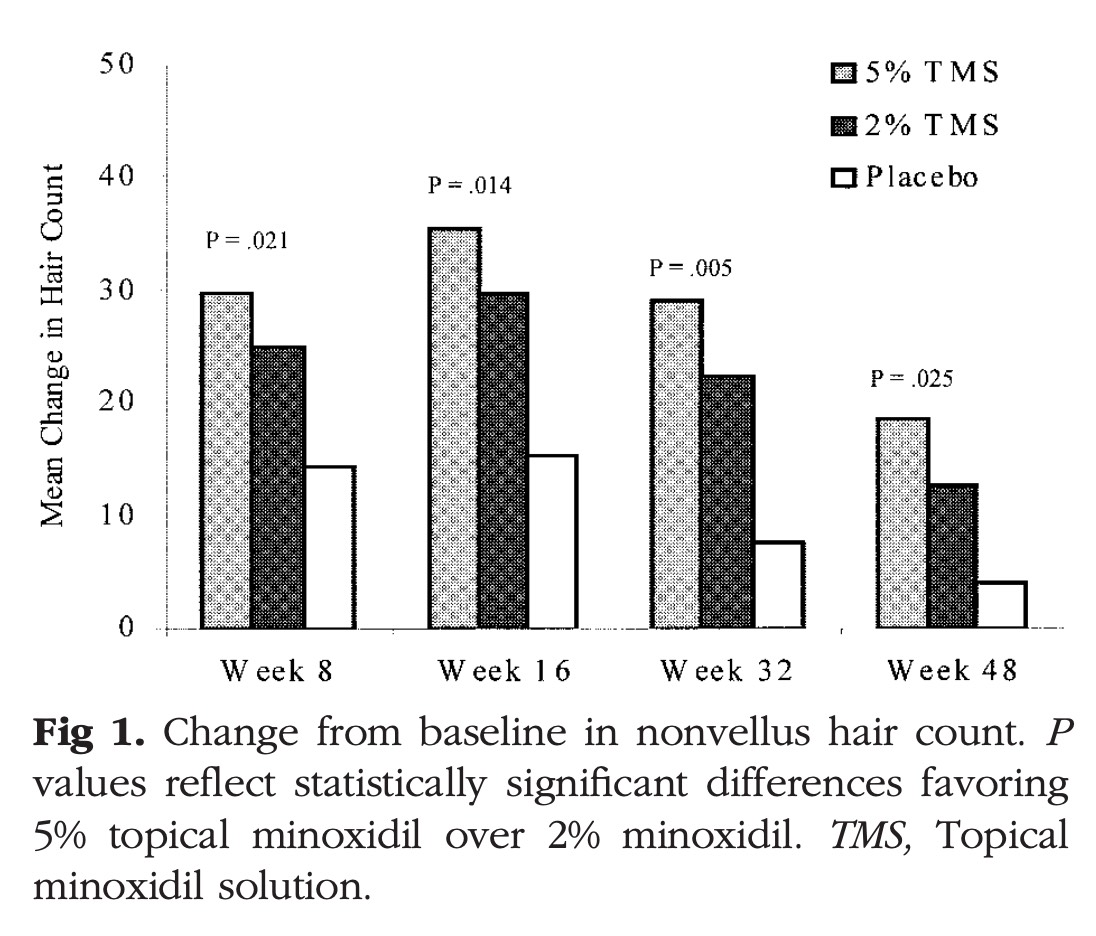
This is echoed on 5-year studies on minoxidil, which show a steady decline in non-vellus hair counts in target areas after year one: [7]https://pubmed.ncbi.nlm.nih.gov/2180995/
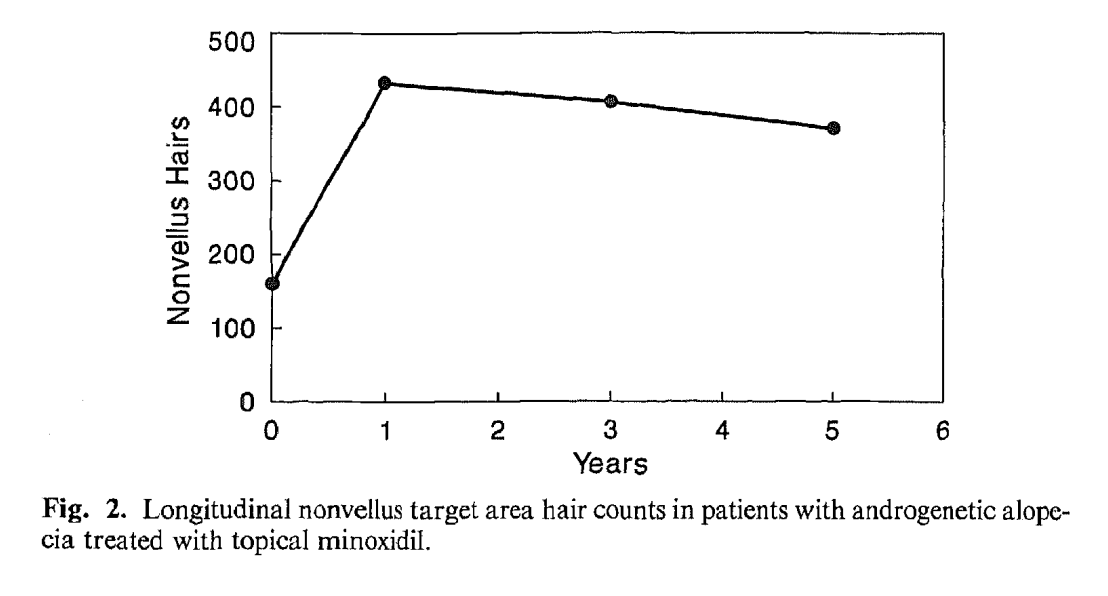
Somewhat relatedly, other studies have demonstrated greatly increased hair counts that failed to translate to visual improvements in hair density.[8]https://www.jaad.org/article/S0190-9622(08)00809-8/abstract
Long-story short: over time, minoxidil’s efficacy begins to wane. And while minoxidil can temporarily increase hair counts, these increases don’t always lead to cosmetic levels of hair regrowth.
Why is this?
Minoxidil helps kickstart hairs back into the anagen (growth) phase of the hair cycle. However, it doesn’t address DHT-driven hair follicle miniaturization. So, while hair counts increase, hair diameters continue to decline, leading to a loss of hair volume and thereby hair thinning over time.
Most people who try minoxidil quit within a year as their results stabilize or slowly decline.
Let’s take a closer look at why, and what happens when they do.
Why Stop Taking Minoxidil?
People who stop taking minoxidil tend to fall into two main camps. Either minoxidil is just not working for them at all, or it is working, but for various reasons, they’d prefer to pass on a twice-daily application for the rest of their lives.
Minoxidil Non-Responders
Some people simply don’t respond to minoxidil. This could be a sign their hair loss stems from a condition other than androgenic alopecia. But as we’ll see, minoxidil just doesn’t always work well on its own.
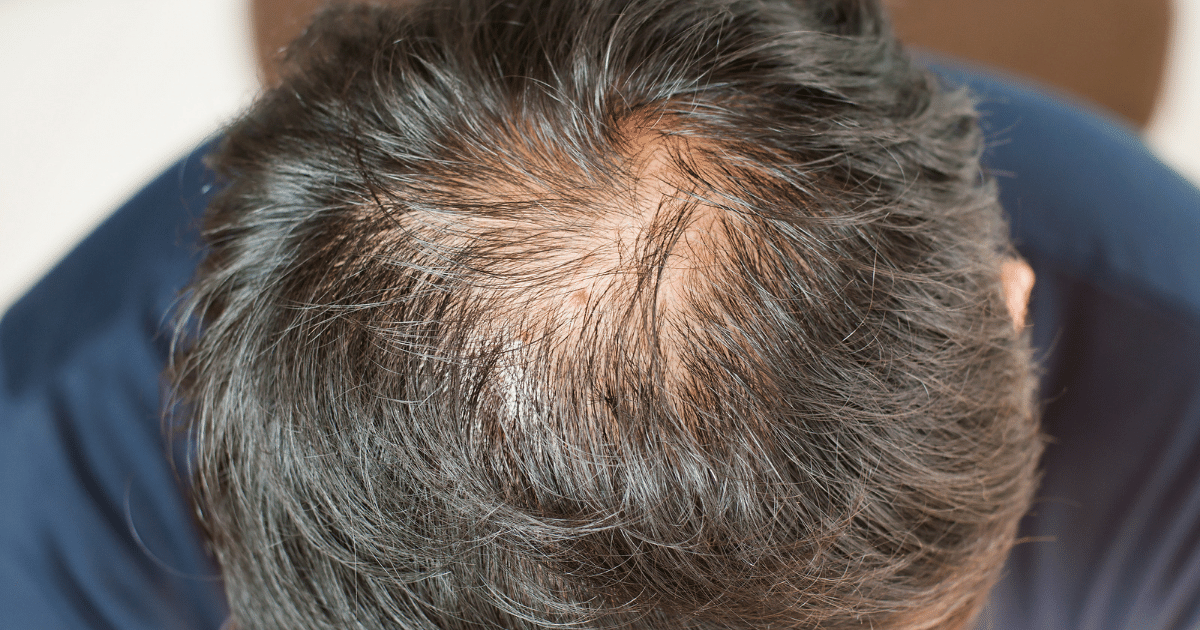
Is it Androgenic Alopecia?
Non-response to minoxidil could signify that hair loss is not due to androgenic alopecia but something else. There’s some evidence that oral minoxidil might improve hair shedding disorders like chronic telogen effluvium, but it’s technically not FDA-approved for that condition.[9]https://link.springer.com/article/10.1007%2Fs40257-018-0409-y
Is it Strong Enough?
When choosing between 2% and 5%, choose the more potent formula. Studies show that in men, 5% minoxidil is better than the 2% formula, and the same is likely true for women. Prescriptions are available for concentrations of 10% or 15%, and studies show minoxidil non-responders often see better hair growth after switching to these strengths.[10]https://pubmed.ncbi.nlm.nih.gov/28078868/
Is it in Use as a Monotherapy?
The reality is that minoxidil just isn’t very effective by itself. To understand why it helps to learn about an enzyme called Sulfotransferase.
In order to become active, minoxidil must come into contact with Sulfotransferase. About 40% of balding men just don’t have enough Sulfotransferase to elicit a response to Minoxidil – which happens to closely correspond with the percent of non-responders of minoxidil.
What might help increase Sulfotransferase levels? We’ll get to that later.
The Downsides of Minoxidil
Even minoxidil responders may not want to use it forever. It can be costly and inconvenient, and it does have some minor side effects.
Cost
Monthly minoxidil use costs between $15-$40. Hair loss sufferers will need to try it for 6 months and spend close to $200 just to see if they’re a responder. Stick with it for years, and they could end up spending thousands. Some users find that as their results taper off, it no longer warrants the ongoing expense.
Note: the price of minoxidil can be dramatically reduced by purchasing in bulk and through big brands – like the minoxidil offered from Kirkland. But these formulations tend to come with propylene glycol and other carrier ingredients that can irritate the scalp.
Side Effects
The biggest side effect of minoxidil seems to be skin irritation. Between 2% to 6% of users report this.[11]https://www.researchgate.net/publication/221695328_Minoxidil_Use_in_Dermatology_Side_Effects_and_Recent_Patents However, allergy testing suggests that up to 80% of skin-irritation related side effects from minoxidil may not be caused by the minoxidil itself, but rather, a carrier ingredient called propylene glycol.[12]http://www.thaiscience.info/Journals/Article/JMAT/10986429.pdf
There are brands that offer minoxidil without propylene glycol, so be sure to check the labels if you have any concerns of allergies.
Additional side effects include toxicity to cats, under-eye bags, and potential heart palpitations. But these are all relatively rare.
Inconvenience
As hair growth treatments go, minoxidil is relatively easy and convenient. Still, not everyone wants to commit to twice-daily use for the rest of their lives, regardless of its effectiveness. And as we mentioned earlier, minoxidil alone is not an effective long-term treatment. To keep results from waning, using minoxidil in combination with other therapies is recommended, which only adds time and expense.
So if someone decides to stop taking minoxidil, what are the expectations?
What Happens When Stopping Minoxidil

In 1999, researchers conducted a study on the effects of abruptly ceasing minoxidil after long-term treatment.[13]https://www.jaad.org/article/S0190-9622(99)70006-X/fulltext Not only did the group who stopped minoxidil shed hair, but for a month or two, they actually crossed below the threshold of where they would have been if they’d never used minoxidil to begin with.
Let’s take a closer look at what happened.
The Study on Stopping Minoxidil
Researchers spent more than two years following four separate cohorts. One group was treated with 2% minoxidil, another group with 5%, one group was given a placebo, and the fourth group did nothing.
Both the 2% and 5% groups saw improvements in hair counts by the three-month mark. As we’ve said, these improvements leveled off a bit from that point forward but were still higher than hair counts in the placebo and control groups.
After almost two years of treatment, at the 96-week mark, the investigators took the people in the 2% and 5% minoxidil groups and discontinued treatment. We can see the exact moment this occurred by looking at the data on hair weights, which soon started decreasing.
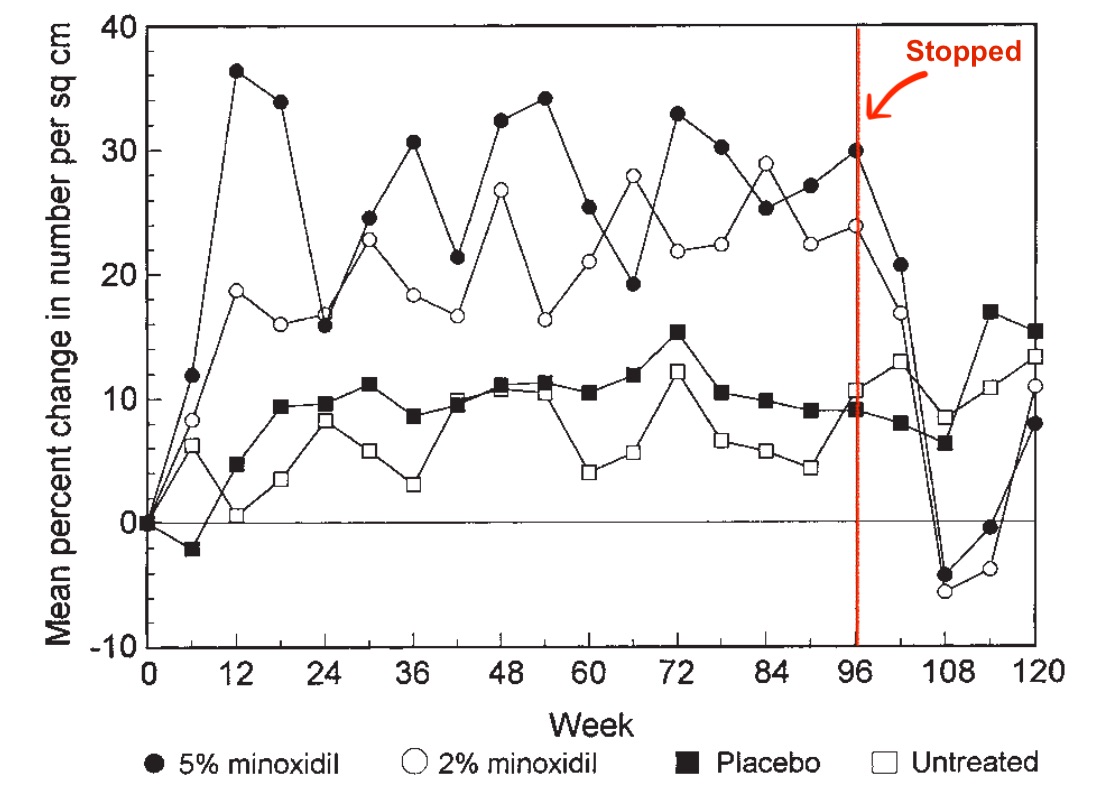
Three months later, by week 108, their hair loss had dipped well below the placebo group and below where they were at the start of the study. Another three months after that, by week 120, both the 2% and 5% groups had rebounded to rejoin toss sufferers will end up right where they started.
As mentioned, any excess shedding should not be permanent, as hair will readjust to new homeostasis without the drug.
So the question becomes, is there a method to weaning from minoxidil that can prevent or reduce shedding?
Is Minoxidil Plus Microneedling the Answer?
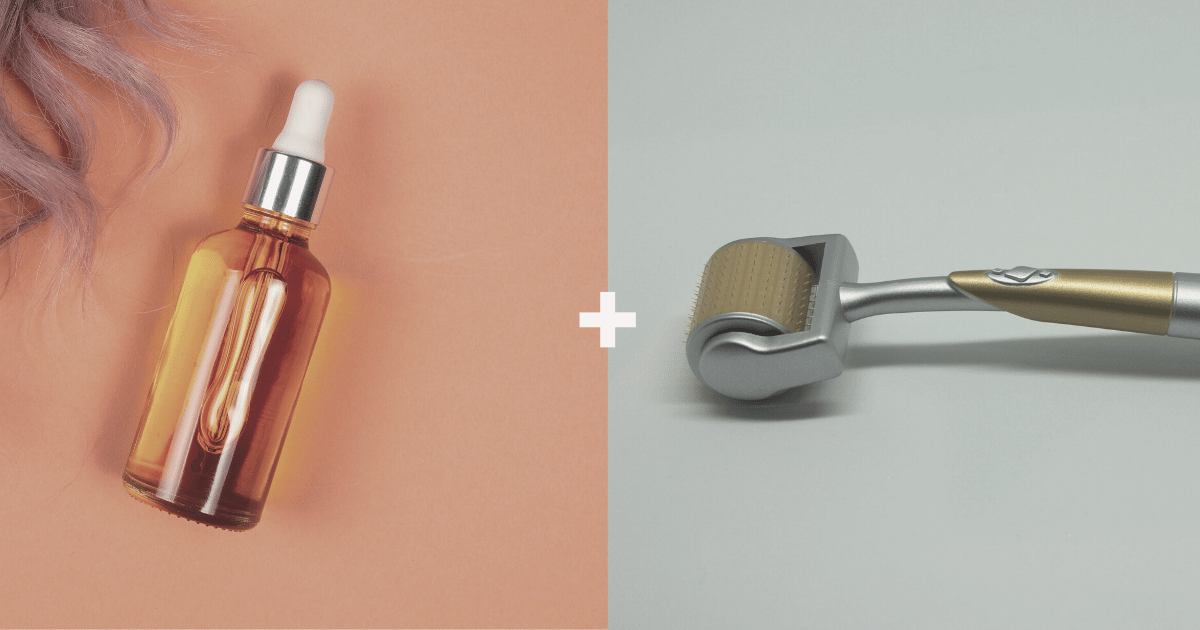
In the above study, minoxidil was used as a monotherapy. And we know from the research that combining minoxidil with additional therapies, such as microneedling, can improve outcomes for non-responders and may prevent results from waning after the initial 3-6 months of usage.
So could microneedling also prevent (or delay) shedding if one decides to stop taking minoxidil? Let’s investigate what happens when we use these two therapies in tandem.
About Microneedling
Microneedling is a micro-wounding procedure that involves pricking the skin with tiny needles using either a roller or a pen-shaped tool. Studies have shown microneedling elicits growth factors, signaling proteins, and the enzymatic activity of Sulfotransferase, which we referred to earlier.
In some studies, Microneedling plus Minoxidil seems to elicit a fourfold greater effect on hair count increases than Minoxidil alone.[14]https://www.ncbi.nlm.nih.gov/pmc/articles/PMC3746236/
In fact, when combining minoxidil with microneedling, new data show that all new hair gains might hold for much longer – even after quitting all treatments.
The Data on Combined Therapies
Let’s take a closer look at a 2020 study to see why microneedling could be the key to maintaining hair growth, even after quitting minoxidil.[15]https://pubmed.ncbi.nlm.nih.gov/29028377/
In the study, researchers split men into 3 groups. One treated their hair loss with minoxidil only, another group with microneedling only, and one group combined the two therapies. As other studies have shown, the combined therapies were significantly more effective in terms of hair growth.
But what the researchers did next was interesting. They stopped all treatments for each of the 3 groups, then brought them in 6 months later to ask, ‘how much hair growth did you retain, even in the absence of treatment?’ Here were their results:
- Minoxidil Only – 90% lost all new hair growth (just 10% retained new growth)
- Microneedling Only – 70% retained some new hair, 20% retained all new hair, 10% lost all new hair
- Combined Therapies – 70% retained some new hair, 20% retained all new hair, 10% lost all new hair
So the group that combined minoxidil with microneedling not only experienced at least twice the hair growth of the other two groups, but 70% of them held on to at least some of this new growth, even after stopping all treatments. And yet, before we conclude that microneedling plus minoxidil is a fail-safe method for maintaining hair growth after treatment ends, there are some possibilities to consider.
- It’s possible if researchers asked the same question 12 months versus 6 months later, all groups would report an equal amount of hair loss. We’ve seen with other therapies, Finasteride for example, that gains disappear over a longer timeline.
- While the number 70% sounds big, the sample size in this study was relatively small. Each group contained just 20 men. So, while it’s great that 14 men maintained at least some of their results for 6 months after treatment ended, it’s possible this percentage could change within a larger sample.
So, while the study above is promising, we don’t really have enough data to definitively say whether or not hair shedding after quitting minoxidil can be prevented.
We’ve yet to see any literature that would help predict who will or will not shed badly from minoxidil. However logically, it may be that those who respond better to minoxidil (or the more hair minoxidil helps one keep during use) simply have more hair to lose during withdrawal.
Anecdotally, about 50% of the male Perfect Hair Health members who have slowly weaned from minoxidil while maintaining microneedling therapy noticed no cosmetic differences in their hair counts afterward.
Basically, they’re able to maintain similar visuals even without the drugs. The other 50% do see a decline visually, but it’s nowhere near baseline or very rarely all the way back to baseline.
If hair loss sufferers do get to a point where they’re happy with their hair and want to wean away from drugs, doing so with the right tapering protocol while continuing the use of microneedling could be a solution.
The Best Way to Quit Minoxidil
When is the best time to call it quits? Never, if you’d like to take as much risk off the table as you can.
Otherwise, the following tips may help minimize any shedding related to minoxidil withdrawals.
- Start microneedling before quitting. Minoxidil and microneedling are synergistic treatments. Try them together for at least 3-6 months before dropping the drug.
- Don’t quit cold turkey. Follow a tapering protocol to minimize abrupt changes to the scalp environment. (We have a detailed weaning protocol in our membership.)
- Continue with alternative treatments. An effective weaning protocol takes up to 6 months. Continue with microneedling during this time.
- Replace minoxidil with natural therapies. Individuals may wish to experiment with other topicals instead, such as 2-5% rosemary oil.
For the most part, minoxidil requires lifelong use to hold onto any hair maintained or regrown. As such, shedding often occurs for 3-6 months following a stop in minoxidil application. But, we can significantly mitigate this shed by combining minoxidil with additional therapies and following a tapering protocol.
Summary
Minoxidil can be an effective treatment for androgenic alopecia, although research says when used alone, results taper off over time. Combining minoxidil with wounding therapies such as microneedling can make it more effective.
When stopping minoxidil, hair loss can be expected. Research shows losses will be greatest within the first 3-6 months of quitting but will eventually rebound to where hair counts would have been had minoxidil never been applied.
This doesn’t mean hair loss sufferers are stuck taking minoxidil for the rest of their lives. The same microneedling therapies that make minoxidil more effective may help sustain results after quitting the drug. This is especially true for those who commit to a strict tapering protocol versus quitting minoxidil cold turkey.
So should people use minoxidil?
For many, it’s worth a try. Some people will see visual improvements, some of which can be maintained with a proper weaning program. In the worst case, people will most likely end up where they would’ve been without treatment, but not worse off.

Rob English is a researcher, medical editor, and the founder of perfecthairhealth.com. He acts as a peer reviewer for scholarly journals and has published five peer-reviewed papers on androgenic alopecia. He writes regularly about the science behind hair loss (and hair growth). Feel free to browse his long-form articles and publications throughout this site.
References
| ↑1 | https://www.jaad.org/article/S0190-9622(08)00809-8/abstract |
|---|---|
| ↑2 | https://pubmed.ncbi.nlm.nih.gov/9395721/ |
| ↑3 | https://www.jidonline.org/article/S0022-202X(15)42806-4/pdf |
| ↑4 | https://pubmed.ncbi.nlm.nih.gov/21524889/ |
| ↑5 | https://www.sciencedirect.com/science/article/pii/S019096229970006X |
| ↑6 | https://pubmed.ncbi.nlm.nih.gov/12196747/ |
| ↑7 | https://pubmed.ncbi.nlm.nih.gov/2180995/ |
| ↑8 | https://www.jaad.org/article/S0190-9622(08)00809-8/abstract |
| ↑9 | https://link.springer.com/article/10.1007%2Fs40257-018-0409-y |
| ↑10 | https://pubmed.ncbi.nlm.nih.gov/28078868/ |
| ↑11 | https://www.researchgate.net/publication/221695328_Minoxidil_Use_in_Dermatology_Side_Effects_and_Recent_Patents |
| ↑12 | http://www.thaiscience.info/Journals/Article/JMAT/10986429.pdf |
| ↑13 | https://www.jaad.org/article/S0190-9622(99)70006-X/fulltext |
| ↑14 | https://www.ncbi.nlm.nih.gov/pmc/articles/PMC3746236/ |
| ↑15 | https://pubmed.ncbi.nlm.nih.gov/29028377/ |

